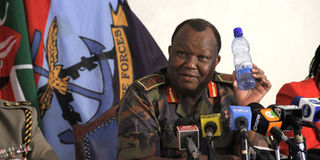Too many questions left unanswered

General Julius Karangi addresses the press where he said soldiers did not steal at the Westgate Mall. PHOTO | FILE | NATION
What you need to know:
- Information coming out contradicts official statements from government
- How many attackers were involved?
- What was initially thought to be an ordinary robbery turned out to be one of the worst terrorist attacks in Kenya’s history.
President Uhuru Kenyatta and Interior Cabinet Secretary Joseph ole Lenku initially said 10 to 15 heavily armed attackers were at Westgate with one thought to be British terrorist Samantha Lewthwaite.
Reports on September 21 also alleged one of the gunmen had been arrested but died in hospital. And after the siege, Mr Lenku said five terrorists had died. But CCTV footage obtained by Sunday Nation days later — and subsequent leaked clips — showed only four attackers armed with AK-47 rifles.
The authorities have never explained the inconsistencies.
Who was responsible for the bungled security operation?
What was initially thought to be an ordinary robbery turned out to be one of the worst terrorist attacks in Kenya’s history. A handful of police officers and armed civilians initially took on the attackers before the elite Recce Squad of the General Service Unit arrived. But there are indications that when the military came in hours later, complete with armoured vehicles, there was no coordination, and the soldiers ended up shooting at the police inside the mall. The subsequent changeover is thought to have given the terrorists time to regroup.
While Inspector-General of Police David Kimaiyo was nominally in charge, Kenya Defence Forces Chief Julius Karangi was said to have been directing the operation.
The question why it took four days and blowing up a building to stop four men armed with light weapons and not holding any hostages lingers. And why was there a glaring lack of coordination between the police and the military?
Were the terrorists killed or did they slip away as the security forces fought to take control of the building?
Initial eyewitness accounts claimed some terrorists may have dropped their weapons, changed clothes and melted into the crowd in the early stages of the attack.
Other reports on September 22 alleged the attackers escaped through a tunnel connecting the mall and a nearby building. A New York Police Department report last November claimed all the terrorists escaped. None of these claims have been proved.
What is clear is that the last CCTV footage on Sunday night showed the four terrorists praying in a Nakumatt storeroom with one later interfering with the camera.
After sections of the building were blown up to end the siege, there was no evidence that the terrorists’ bodies had been recovered. Mr Lenku said immediately after the attack that five gunmen had been killed — even though it later emerged there were only four terrorists. Gen Karangi later claimed the remains were given to the FBI. The FBI itself has said it believed the terrorists were killed but no DNA evidence has been released.
WHO LOOTED THE SHOPS?
Traders who entered the building after the siege reported that some shops had been looted and automated teller machines broken into. Footage obtained by the Sunday Nation a few days after the attack showed soldiers leaving Nakumatt with plastic bags containing unidentified items.
Some soldiers were also seen ransacking the till in an M-Pesa booth. KDF later explained that soldiers had only been allowed to take bottled water from the supermarket. So, who looted the shops?
Why was the building blown up?
Mr Lenku explained that smoke from the building on September 23 was caused by the terrorists burning mattresses to distract the security forces. An explosion was later heard, with speculation that it was the terrorists blowing up the building. But it later emerged that KDF blew up the building. Why did the soldiers have to blow up the building?
Was intelligence ignored?
The blame game pitting the National Intelligence Service against the police started after the attack. NIS claimed it warned of an impending attack, but the police said the reports were too general to be acted on.
What followed was a series of confidential reports leaked to journalists, mostly detailing the al-Shabaab threat. To date there has never been clarity on whether the intelligence had been taken into account.



